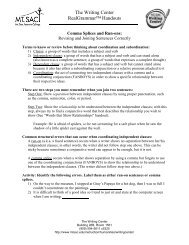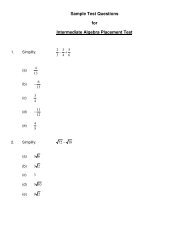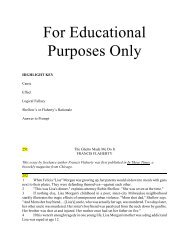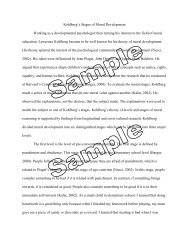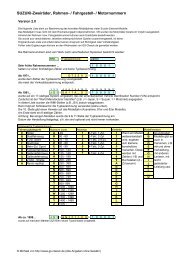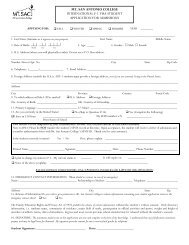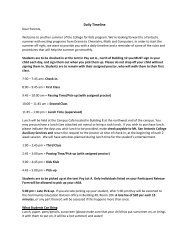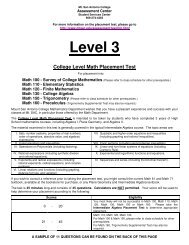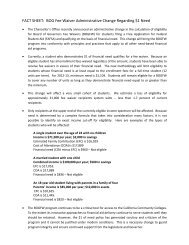DENSITY OF SODIUM CHLORIDE SOLUTIONS
DENSITY OF SODIUM CHLORIDE SOLUTIONS
DENSITY OF SODIUM CHLORIDE SOLUTIONS
You also want an ePaper? Increase the reach of your titles
YUMPU automatically turns print PDFs into web optimized ePapers that Google loves.
<strong>DENSITY</strong> <strong>OF</strong> <strong>SODIUM</strong> <strong>CHLORIDE</strong> <strong>SOLUTIONS</strong><br />
CHEMICALS AND MATERIALS<br />
NaCl(s)<br />
water<br />
EQUIPMENT TO BE CHECKED OUT<br />
5-mL graduated pipet<br />
250mL volumetric flask<br />
25mL buret<br />
25mL Erlenmeyer flask with stopper<br />
SAFETY<br />
Goggles must be worn in the laboratory.<br />
WASTE DISPOSAL<br />
All solutions may be rinsed down the sink<br />
EXPERIMENTAL PROCEDURE:<br />
Your instructor will assign you a specific molarity of sodium chloride solution to prepare.<br />
You will prepare 250 mL of this solution and then measure its density by weighing specific<br />
volumes of the solution on the analytical balance. Your instructor may assign one or all of<br />
the methods for determining density from steps 2-4 below.<br />
1. Prepare 250 mL of your assigned concentration of sodium chloride solution. Record<br />
the exact mass of sodium chloride used.<br />
2. Use your 5-mL graduated pipet to transfer 5.00 mL of your prepared solution to the<br />
25-mL volumetric flask (keep stopper on after transferring to avoid evaporation<br />
losses) and measure the mass of this solution on an analytical balance. Repeat this<br />
procedure until you have 5 consecutive trials that agree within 0.2% (or about 0.02 g).<br />
3. Use your 10-mL volumetric pipet to transfer 10.00 mL of your prepared solution to<br />
the 25-mL volumetric flask (keep stopper on after transferring to avoid evaporation<br />
losses) and measure the mass of this solution on an analytical balance. Repeat this<br />
procedure until you have 5 consecutive trials that agree within 0.2% (or about 0.02 g).<br />
4. Use a buret to sequentially transfer approximately 5 mL aliquots of your solution to<br />
the pre-weighed weighing vial and weigh the transferred solution (do not empty the<br />
weighing vial—add each additional 5mL to it). Repeat until you have delivered a<br />
total of 20 mL of solution to your weighing vial. Note that it is not important to<br />
transfer exactly 5.00 mL each time, but it is important to know precisely what volume<br />
of solution was transferred—record the exact buret readings.<br />
66



